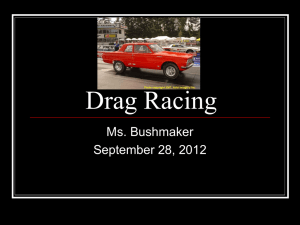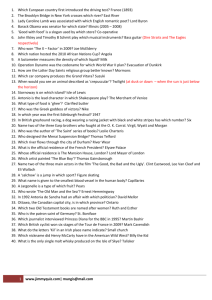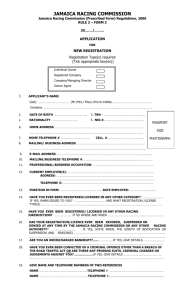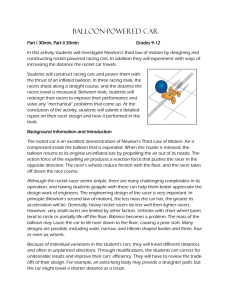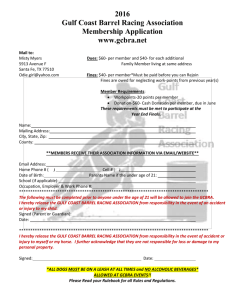Kid Racers Introduction This teacher's guide helps teach young
advertisement
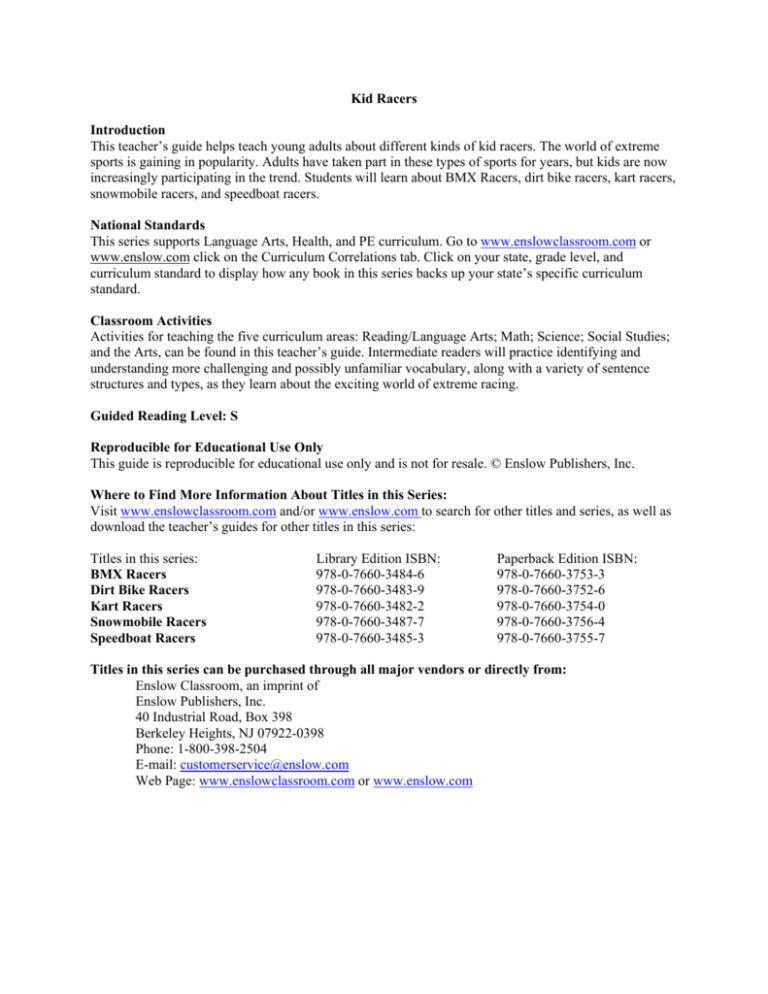
Kid Racers Introduction This teacher’s guide helps teach young adults about different kinds of kid racers. The world of extreme sports is gaining in popularity. Adults have taken part in these types of sports for years, but kids are now increasingly participating in the trend. Students will learn about BMX Racers, dirt bike racers, kart racers, snowmobile racers, and speedboat racers. National Standards This series supports Language Arts, Health, and PE curriculum. Go to www.enslowclassroom.com or www.enslow.com click on the Curriculum Correlations tab. Click on your state, grade level, and curriculum standard to display how any book in this series backs up your state’s specific curriculum standard. Classroom Activities Activities for teaching the five curriculum areas: Reading/Language Arts; Math; Science; Social Studies; and the Arts, can be found in this teacher’s guide. Intermediate readers will practice identifying and understanding more challenging and possibly unfamiliar vocabulary, along with a variety of sentence structures and types, as they learn about the exciting world of extreme racing. Guided Reading Level: S Reproducible for Educational Use Only This guide is reproducible for educational use only and is not for resale. © Enslow Publishers, Inc. Where to Find More Information About Titles in this Series: Visit www.enslowclassroom.com and/or www.enslow.com to search for other titles and series, as well as download the teacher’s guides for other titles in this series: Titles in this series: BMX Racers Dirt Bike Racers Kart Racers Snowmobile Racers Speedboat Racers Library Edition ISBN: 978-0-7660-3484-6 978-0-7660-3483-9 978-0-7660-3482-2 978-0-7660-3487-7 978-0-7660-3485-3 Paperback Edition ISBN: 978-0-7660-3753-3 978-0-7660-3752-6 978-0-7660-3754-0 978-0-7660-3756-4 978-0-7660-3755-7 Titles in this series can be purchased through all major vendors or directly from: Enslow Classroom, an imprint of Enslow Publishers, Inc. 40 Industrial Road, Box 398 Berkeley Heights, NJ 07922-0398 Phone: 1-800-398-2504 E-mail: customerservice@enslow.com Web Page: www.enslowclassroom.com or www.enslow.com Kid Racers Teacher’s Guide for Dirt Bike Racers Young adults are fascinated by learning about their age peers doing interesting things. Most young adults are involved in some type of sport, whether in school or in their community. Using exciting and engaging color photographs, this book centers around showing readers what it is like to be a part of extreme sport racing. Readers will identify with the young adults in the book through biography spotlight features repeated throughout the book. These features, along with the vivid images created by the language structures, can lead to discussions about racing dirt bikes and why people are so interested in this sport. Here is some basic information to point out to students as they are reading. History Motocross racing started in England in the 1920s. It began when motorcyclists wanted to see who could ride the fastest on rough off-road terrain. In those times, the only obstacles on a race track were bumps and hills like the ones found in a field. The earliest motorcycles were little more than bicycles with small internal combustion engines attached. When people began to race with motorcycles, sometimes they used the tracks built for bicycle racing. In the earliest days of the 20th century, manufacturers entered their motorcycles in competitive events to publicize their brand and prove their performance and durability, just as they still to today. In 1924, the first known British off-road event known as the Scrambles was held. Over the years, the event evolved largely through the efforts of riders from Europe who shortened the tracks while adding laps and various obstacles through the course. For more information on the history of the sport, visit <www.motorcyclemuseum.org>. Equipment A motocross bike is powered by a gasoline engine. A twist throttle on the right handgrip controls the power of the engine. A clutch lever near the left handgrip controls the amount of power that passes to the transmission. The front brake lever can be found near the right handgrip and the rear brake lever can be found near the right footpeg. Refer to the diagram of the motocross bike on page 9 of the book for a visual of this description. The most important piece of safety equipment for a motocross bike rider is a helmet. The helmet must fit snugly against a rider’s head for maximum protection. Riders will also need eye goggles, boots, kneepads, a check protector, elbow pads, riding pants, a chest protector, a neck brace, and gloves. All of this equipment is necessary for the safety of the rider. Team Building Motocross racing is a family-oriented activity. Family members often work as teammates at races. Parents and their children often race together and act as one another’s crew. Racing teaches the whole family about teamwork, but more importantly, it gives families an opportunity to spend together outside of their busy, daily lives. The Five Curriculum Activities SAFETY WARNING: Before any activity, make sure your students do not have any allergies to items that you might use. Never use anything that is sharp or may cut a student. Do not use anything too hot or cold which might injure any student. Always have an adult supervise all activities to ensure the safety of your students. Reading/Language Arts activity: Young adults will find many new vocabulary words throughout the book. Almost all words, however, are explained with the content of the text. If students have difficulty with understanding a content-specific term, additional information on certain words that are specific to this book can be found in the Glossary on pages 44 and 45. Invite students to locate at least one unfamiliar word and find its meaning in the Glossary. Encourage students to write a content-specific sentence using the unfamiliar word. Math activity: Ask students to think about the different types of bikes presented in the book. Have students group the bikes into two categories of their choosing. Ask students what criteria they used to put the bikes into their chosen categories. Talk about similarities and differences. Have students draw a Venn diagram and fill it in with information from the two categories. Invite students to share their completed diagram with a partner or the group. Science activity: After reading the section on the environment on pages 42 and 43, lead a discussion about why it is important to protect the environment and how motocross bike racers can participate in the effort. To learn more about one area’s fight to protect the environment while still respecting motocross racers, visit <http://www.cbc.ca/canada/prince-edward-island/story/2009/06/01/pei-mudrooters-environment.html>. Social Studies activity: Several different racing locations are mentioned throughout this book, such as a course at the Jolly Roger Moto-Sports Park in Lempster, New Hampshire. Using a map of the United States, find each location that is mentioned in the book. Are there certain areas of the country where racing is more popular than others? If so, why might this be? Discuss the possible circumstances that might make certain areas popular with dirt bike racers. Arts activity: Have students use the information on pages 42 and 43 to create a “Save the Environment” poster. Remind students of their discussion during the science activity. Encourage students to be creative with the materials used for their posters. When all posters are complete, hang them around the room or in the hall for others to view and enjoy. Answers for Worksheet: 1. c. Hare Scrambles; 2. b. Hillclimb racing; 3. Dirt Track racing; 4. c. TT racing; 5. b. Motocross racing Choose the best answer to fill in the blank. Circle the best answer. 1. A _____________ is a race of several laps around a marked trail in the woods. a. TT racing b. Dirt Track racing c. Hare Scrambles 2. In _____________ racing, riders see who can make it up a hill the fastest. a. Hare Scrambles b. Hillclimb racing c. Dirt Track racing 3. In ____________ racing, riders race around an oval-shaped course and go counterclockwise. a. Dirt Track racing b. Hillclimb racing c. TT racing 4. In ____________ racing, the course has at least one right turn and one jump. a. Hare Scrambles b. Dirt Track racing c. TT racing 5. In ____________ racing, riders complete several laps around a course of jumps, turns, hills, and bumps. a. Dirt Track racing b. Motocross racing c. Hillclimb racing ©Enslow Publishers, Inc. www.enslowclassroom.com
